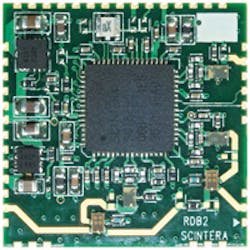Amplifier linearity is often difficult to achieve, calling for a series of design tradeoffs that can affect bandwidth, power levels, spectral purity, and efficiency. But with the models SC1869 and SC1889 system-on-chip (SoC) devices from Scintera Networks, analog signal processing is applied to smaller cellular amplifiers to deliver improved linearity at frequencies from 698 to 2800 MHz (see figure). These SoCs are RF power amplifier linearizer (RFPAL) circuits fabricated in a standard 0.18-μ silicon CMOS process and housed in 9 x 9 mm 64-pin QFN packages for ease of integration in cell-site amplifiers.
Both SoCs are usable from 698 to 2800 MHz. They work with RF input and output signals for simple implementation in any application without direct access to a host processor. These SoCs are also well suited for traditional in-cabinet base-transceiver-station (BTS) amplifiers, microwave repeaters, booster amplifiers, microcells, picocells, and multiple-input, multiple-output (MIMO) communications systems. They work by measuring the feedback signal from an amplifier's output port, then optimizing the correction signal and applying it to the amplifier to achieve minimal distortion. As the adaptive RF predistortion signal processing is performed directly on the RF carrier, the RFPAL SoCs inject the correction signals needed for linearization only where needed, at the input of the power amplifier. Their optimized correction signals can reduce out-of-band energy and increase amplifier efficiency, compensating for amplifier nonlinear behavior, such as AM-to-AM distortion, AM-to-PM distortion, and spectral regrowth.
The two new SoCs are aimed at amplifiers to 10 W output power, as well as higher-power amplifiers operating through 60 W output power. Model SC1869 supports instantaneous bandwidths to 20 MHz and is optimized for use with Class A/AB amplifiers handling from 0.5 to 10 W average output power. Model SC1889 supports instantaneous bandwidths to 60 MHz and can be used with either Class A/AB or Doherty amplifiers operating to 60 W average output power.
Model SC1869 is suitable for Class A and AB amplifiers operating to 10 W output power and includes support for EVDO, TD-SCDMA, WiMAX, HSDPA, LTE, and TD-LTE waveforms. It can be configured to consume less than 400 mW power, and is small in size (with a system footprint of less than 6.5 cm2, helping to reduce the size and operating costs of wireless base-station amplifiers. The SoC achieves higher amplifier linearity and efficiency and represents an effective alternative to operating the amplifier in backoff mode. The reduced amplifier distortion and improved spectral purity can mean as much as a 20-dB improvement in adjacent-channel leakage ratio (ACLR) compared to nonlinearized amplifier performance.
Model SC1889 is optimized for Class A and AB amplifiers, as well as Doherty amplifiers operating at average power levels to 60 W. As with the SC1869, it can provide correction for a wide range of systems, including for EVDO, TD-SCDMA, WiMAX, HSDPA, LTE, and TD-LTE waveforms. It can achieve power consumption as low as 450 mW when used with a 10% feedback duty cycle, and maintains power consumption to only 1.2 W even at 100% duty-cycle operation. Its impact on the system is a small footprint of less than 9 cm2. The performance improvements are dramatic, however, with as much as a 28-dB improvement in ACLR performance.
The SoCs can linearize a wide range of amplifiers through 2800 MHz, including those based on different process technologies such as silicon LDMOS, GaN, and GaAs. Both SoCs are fully RoHS compliant and require only minimal external passive components. Both are rated for case temperatures from -40 to +100C. (To learn more about the technology behind the SC1869 and SC1889, don't miss the article by Scintera's Mendy Ouzillou in the August 2011 issue of Microwaves & RF.)
Scintera Networks, Inc.
1154 Sonora Court
Sunnyvale, CA 94086
(408) 636-2600
FAX: (408) 636-2601
About the Author
Jack Browne
Technical Contributor
Jack Browne, Technical Contributor, has worked in technical publishing for over 30 years. He managed the content and production of three technical journals while at the American Institute of Physics, including Medical Physics and the Journal of Vacuum Science & Technology. He has been a Publisher and Editor for Penton Media, started the firm’s Wireless Symposium & Exhibition trade show in 1993, and currently serves as Technical Contributor for that company's Microwaves & RF magazine. Browne, who holds a BS in Mathematics from City College of New York and BA degrees in English and Philosophy from Fordham University, is a member of the IEEE.
